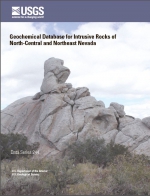Добрый день, Коллеги. Важное сообщение, просьба принять участие. Музей Ферсмана ищет помощь для реставрационных работ в помещении. Подробности по ссылке
Geochemical database for intrusive rocks of north-central and northeast Nevada
Data presented in this report pertain to the igneous intrusions of north-central and northeast Nevada and were compiled as part of the Metallogeny of the Great Basin project conducted by the U.S. Geological Survey between 2001 and 2007. The geographic area addressed in this compilation is approximately bounded by lats 38.5° and 42°N., long 118.5° W., and the Nevada-Utah border (fig. 1). The area contains numerous large plutons and smaller stocks but also contains many small, shallowly emplaced intrusive bodies, including dikes, sills, and intrusive lava dome complexes. The age, composition, and geographic distribution of intrusions in north-central and northeast Nevada (hereafter, the study area) are summarized by du Bray and Crafford (2007). Intrusive igneous rocks, of multiple ages, are known to be major constituents of the geologic framework in the study area (Stewart and Carlson, 1978). Abundant middle to late Mesozoic and early to middle Cenozoic intrusions in the study area are probably byproducts of subduction-related processes, including back-arc magmatism, that prevailed along the west edge of the North American plate during this interval.
Ressel and others (2000) and Ressel and Henry (2006), for example, have highlighted the association between magmatism and ore deposits along the Carlin trend. Similarly, Theodore (2000) has demonstrated the association between igneous intrusions and ore deposits in the Battle Mountain area. Decades of geologic investigations in the study area demonstrate that many ore deposits, representing diverse ore deposit types, are spatially, and probably temporally and genetically, associated with igneous intrusions. Because of these associations, studies of many individual igneous intrusions have been completed, including those by a large number of Master’s and Doctoral thesis students (particularly University of Nevada at Reno students and associated faculty), economic geologists working on behalf of exploration and mining companies, and U.S. Geological Survey earth scientists. However, despite the
number and importance of igneous intrusions in the study area, no synthesis of geochemical data available for these rocks has been completed.
Data compilations that are available for igneous intrusions in Nevada pertain to relatively restricted geographic areas and (or), in most cases, do not include the broad array of data that would aid interpretation of these rocks. Smith and others (1971) presented potassium-argon geochronologic and basic petrographic data for a few intrusions in north-central Nevada. Similarly, Silberman and McKee (1971) presented potassium-argon geochronologic data for a significant number of central Nevada intrusions. More recently, Mortenson and others (2000) presented uranium-lead geochronology for a small number of intrusions in the study area. Sloan and others (2003) released a national geochronologic database that contains age determinations made prior to 1991 for rocks of Nevada. Finally, Henry and Sloan (2003) compiled geochronologic data for igneous rocks of Nevada produced subsequent to completion of the Sloan and others (2003) compilation. Consequently, although age data for igneous rocks of Nevada have been compiled, data pertaining to compositional features of these rocks have not been systematically synthesized. Maldonado and others (1988) compiled the distribution and some basic characteristics of intrusive rocks throughout Nevada. Lee (1984), John (1983, 1987, and 1992), John and others (1994), and Ressel (2005) have compiled data that partially characterize igneous intrusions in various parts of Nevada. Contained in the text and data that follow is a more complete synthesis of composition and age data for igneous intrusions of the study area. The ultimate goal of this effort is an evaluation of the time-space-compositional evolution of Mesozoic and Cenozoic magmatism in the study area and identification of genetic associations between magmatism and mineralizing processes in this region.




